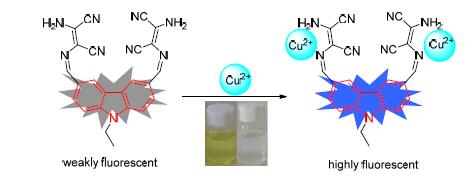| [1] Liu, W. Y.; Li, H. Y.; Lü, H. S.; Zhao, B. X.; Miao, J. Y. Spectrochim. Acta, Part A 2012, 95, 658.
[2] Li, W.; Zhang, Y.; Gan, X. P.; Yang, M. D.; Mie, B.; Fang, M.; Zhang, Q. Y.; Yu, J. H.; Wu, J. Y.; Tian, Y. P.; Zhou, H. P. Sens. Actuators, B: Chem. 2015, 206, 240.
[3] Qin, J. C.; Yang, Z. Y. J. Photochem. Photobiol., A 2016, 324, 152.
[4] Zhang, C. H.; Gao, B. Z.; Zhang, Q. Y.; Zhang, G. M.; Shuang, S. M.; Dong, C. Talanta 2016, 154, 278.
[5] Na, Y. J.; Choi, Y. W.; Yun, J. Y.; Park, K. M.; Chang, P. S.; Kim, C. Spectrochim. Acta, Part A 2015, 136, 1649.
[6] An, R. B.; Zhang, D. T.; Chen, Y.; Cui, Y. Z. Sens. Actuators, B: Chem. 2016, 222, 48.
[7] Yu, H.; Lee, J. Y.; Angupillai, S.; Wang, S.; Feng, S. H.; Matsumoto, S.; Son, Y. A. Photochem. Photobiol., A 2015, 151, 48.
[8] Dusek, P.; Roos, P. M.; Litwin, T.; Schneider, S. A.; Flaten, T. P.; Aaseth, J. J. Trace Elem. Med. Biol. 2015, 31, 193.
[9] Razi, S. S.; Srivastava, P.; Ali R.; Gupta, R. C.; Dwivedi, S. K.; Misra, A. Sens. Actuators, B: Chem. 2015, 209, 162.
[10] Xiong, J. J.; Huang, P. C.; Zhou, X.; Wu, F. Y. Sens. Actuators, B: Chem. 2016, 232, 673.
[11] Li, S.; Zhang, D.; Xie, X. Y.; Ma, S. G.; Liu, Y.; Xu, Z. H.; Gao, Y. F.; Ye, Y. Sens. Actuators, B: Chem. 2016, 224, 661.
[12] Tian, M. Z.; Hu, M. M.; Fan, J. L.; Peng, X. J., Wang, J. Y.; Sun, S. G.; Zhang R. Bioorg. Med. Chem. Lett. 2013, 23, 2916.
[13] Zhu, W. J.; Yang, L. L.; Fang, M.; Wu, Z. Y.; Zhang, Q.; Yin, F. F.; Huang, Q.; Li C. J Fluoresc. 2015, 158, 38.
[14] Danjou, P. E.; Lyskawa, J.; Delattre, F.; Becuwe, M., Woisel, P.; Ruellan, S.; Fourmentin, S.; Dennina, F. C. Sens. Actuators, B: Chem. 2012, 171~172, 1022.
[15] Zhang, J.; Cui, H. L.; Hojo, M.; Shuang, S. M.; Dong, C. Bioorg. Med. Chem. Lett. 2012, 22, 343.
[16] Yang, L. L.; Zhu, W. J.; Fang, M.; Zhang, Q.; Li, C. Spectrochim. Acta, Part A 2013, 109, 186.
[17] Sharma, S.; Pradeep, C. P.; Dhir, A. Mater. Sci. Eng., C 2014, 43, 418.
[18] Feng, G. L.; Geng, L. J.; Wang, T.; Li, J. Y.; Yun, X. D.; Wang, Y. Q.; Li, Y., Xie, D. Y. J Fluoresc. 2015, 167, 65.
[19] Feng, Y.; Li, D. X.; Wang, Q.; Wang, S. X.; Meng, X. M.; Shao, Z. L.; Zhu, M. Z.; Wang, X. Sens. Actuators, B: Chem. 2016, 225, 572.
[20] Li, D. X.; Sun, X.; Huang, J. M.; Wang, Q.; Feng, Y.; Chen, M.; Meng, X. M.; Zhu, M. Z.; Wang, X. Dyes Pigm. 2016, 125, 185.
[21] Kundu, A.; Hariharan, P. S.; Prabakaran, K.; Anthony, S. P. Sens. Actuators, B: Chem. 2015, 206, 524.
[22] Gou, C.; Qin, S. H.; Wu, H. Q.; Wang, Y.; Luo, J.; Liu, X. Y. Inorg. Chem. 2011, 14, 1622.
[23] Chen, H. H.; Guan, R. F.; Cao, D. X.; Liu, Z. Q.; Sun, Y. H.; Ma, L.; Wang, K. N.; Shan, Y. Y. Mater. Lett. 2014, 122, 70.
[24] Wang, W. G.; Li, R.; Song, T. W.; Zhang, C. J.; Zhao, Y. Spectrochim. Acta, Part A 2016, 164, 133.
[25] Velmathi, S.; Reena, V.; Suganya, S.; Anandan, S. J Fluoresc. 2012, 22, 155.
[26] Liu, G.; Shao, J. J Fluoresc. 2012, 22, 397.
[27] Ye, W. P.; Wang, S. X.; Meng, X. M.; Feng, Y.; Sheng, H. T.; Shao, Z. L.; Zhu, M. Z.; Guo, Q. X. Dyes Pigm. 2014, 101, 30.
[28] Wang, L. Y.; Yang, L. L.; Cao, D. J Fluoresc. 2014, 24, 1347.
[29] Kim, H.; Rao, B. A.; Jeong, J. W.; Mallick, S.; Kang, S. M.; Choi, J. S.; Lee, C. S.; Son, Y. A. Sens. Actuators, B: Chem. 2015, 210, 173.
[30] Hammud, H. H.; Shazly, S. E.; Sonji, G.; Sonji, N.; Bouhadir, K. H. Spectrochim. Acta, Part A 2015, 150, 94.
[31] Bu, J.; Duan, H. D.; Wang, X. J.; Xu, T.; Meng, X.; Qin, D. W. Res. Chem. Intermed. 2015, 41, 2767.
[32] Zhu, W. J.; Yang, L. L.; Fang, M.; Wu, Z. Y.; Zhang, Q.; Yin, F. F.; Huang, Q.; Li, C. J. Lumin. 2015, 158, 38.
[33] Liu, W.; Wu, G. Y.; Gu, X. M.; Yuan, X. S.; Li, J. Y.; Wang, H. B. J. Fluoresc. 2015, 25, 557.
[34] Thangavel, S.; Rajamanikandan, R.; Friedrich, H. B.; Ilanchelian, M.; Omondi, B. Polyhedron 2016, 107, 124.
[35] Sharma, S.; Pradeep, C. P.; Dhir, A. Mater. Sci. Eng., C 2014, 43, 418.
[36] Hou, S. H.; Qu, Z. G.; Zhong, K. L.; Bian, Y. J.; Tang, L. J. Chin. J. Org. Chem. 2016, 36, 768 (in Chinese).
(侯淑华, 曲忠国, 钟克利, 边延江, 汤立军, 有机化学, 2016, 36, 768.)
[37] Meng, W. F.; Yang, M. P.; Li, B.; Cheng, Z.; Yang, B. Q. Tetrahedron 2014, 70, 8577.
[38] Jagadeeswari, S.; Paramaguru, G.; Thennarasu, S.; Renganathan, R. J. Mol. Struct. 2014, 1060, 191.
[39] Ramkumar, S.; Manoharan, S.; Anandan, S. Dyes Pigm. 2012, 94, 503.
[40] Budreckiene, R.; Buika, G.; Grazulevicius, J. V.; Jankauskas, V.; Staniskiene, B. J. Photochem. Photobiol., A 2006, 181, 257. |
